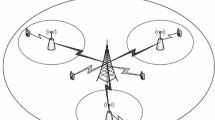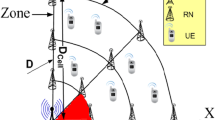Abstract
Inter-Cell Interference (ICI) from neighboring cells is a major challenge that severely degrade the performance of Orthogonal Frequency Division Multiple Access based cellular mobile systems, particularly for cell-edge users. An efficient technique to mitigate ICI is interference coordination. The most commonly Inter-Cell Interfere Coordination technique is Fractional Frequency Reuse (FFR). Furthermore in order to effectively improve cell-edge performance in terms of coverage extension and throughput, the 3rd Generation Partnership Project introduced the use of relays in Long Term Evolution-Advanced (LTE-A) networks to achieve self-backhauling of radio signals between Evolved NodeBs (eNBs) and UEs. This paper introduces a Self-Organized Dynamic FFR Resource Allocation scheme (SODRA-FFR) which dynamically allocates frequency resources to cell inner and outer regions in relay based LTE-A networks to improve cell edge performance and maximize fairness among UEs. In this scheme, the downlink frequency resources are dynamically allocated to cell inner and outer regions and the outer region frequency resources are dynamically distributed between eNB and relay stations in each cell based on coordination between neighboring eNBs and relay stations through a message passing approach over LTE-X2 interfaces. The performance of the proposed SODRA-FFR scheme without and with relays is evaluated using MATLAB simulations and compared with different combinations of frequency resources allocation to cell inner and outer regions as well as with other frequency reuse scheme (i.e., frequency reuse-1 and frequency reuse-3). The results show that the proposed SODRA-FFR scheme improves cell-edge performance and achieves high degree of fairness among UEs compared to reference resource allocation schemes. The results also show that the proposed SODRA-FFR scheme with RSs improves the fairness performance by 30 and 13 % compared to that of frequency reuse-1 and frequency reuse-3 schemes, respectively. In addition, the proposed SODRA-FFR scheme with RSs achieves 55 and 26 % increase in cell-edge throughput compared to that of frequency reuse-1 and frequency reuse-3 schemes, respectively.













Similar content being viewed by others
References
Simon, M. K., & Alouini, M.-S. (2005). Digital communication over fading channels (2nd ed.). New York: Wiley.
IEEE 802.16m. (2009). Evaluation methodology (EMD). In IEEE 802.16m-09-0004r5.
IEEE 802.16m. (2010 January). System requirements document (SDD). In IEEE 802.16m-09-0002r10.
E-UTRA and E-UTRAN Overall description. (2008 Dec). Stage 2 (Release 8), 3GPP technical specification TS 36.300 V8.7.0.
Requirements for Further Advancements for E-UTRA (LTE-Advanced) (Release 8) (2008 Jun) 3GPP technical specification TR 36.913 V8.0.0.
Fodor, G., Koutsimanis, C., Rácz, A., Reider, N., Simonsson, A., & Müller, W. (2009). Intercell interference coordination in OFDMA networks and in the 3GPP long term evolution system. Journal of Communications, 4(7), 445–453.
D4.7.2. (2007). Interference avoidance concepts. WINNER.
Boudreau, G., Panicker, J., Guo, N., Chang, R., Wang, N., & Vrzic, S. (2009). Interference coordination and cancellation for 4G networks LTE part II: 3GPP release 8. IEEE Communications Magazine, 47(4), 74–81.
Siemens. (2005). Interference mitigation—considerations and results on frequency reuse. 3GPP R1-051059.
Texas. (2005). Inter-Cell Interference mitigation for E-UTRA. 3GPP TSG RAN WG1 42bis.
Ericsson. (2005). Inter-cell interference handling for E-UTRA. 3GPP TSG RAN WG1, vol. 42.
Qualcomm. (2006). Description and simulation of interference management techniques for OFDMA based E-UTRA downlink evaluation. 3GPP TSG RAN WG1, vol. 44.
Himayat, N., Talwar, S., Rao, A., & Soni, R. (2010). Interference management for 4G cellular standards. IEEE Communications Magazine, 48(8), 86–92.
Oh, E., Cho, M., Han, S., Woo, C., & Hong, D. (2008). Performance analysis of reuse-partitioning-based subchannelized OFDMA uplink systems in multicell environments. IEEE Transactions on Vehicular Technology, 57(4), 2617–2621.
Liang, D., Zhu, S., Liu, W., & Wang W. (2009). A frequency reuse partitioning scheme with successive interference cancellation for OFDMA uplink Transmission. In Proceedings of the 20th IEEE international symposium on personal, indoor and mobile radio communications (PIMRC 2009) (pp. 1362–1366). Tokyo, Japan.
He, C., Liu, F., Yang, H., Chen, C., Sun, H., May, W., & Zhang, J. (2007). Co-channel interference mitigation in MIMO-OFDM system. In Proceedings of the international conference on wireless communication, networking and mobile computing 2007 (WiCom 2007) (pp. 204–208). Shanghai, China.
Hassan, N. U, & Assaad, M. (2008). Optimal Fractional Frequency Reuse (FFR) in multicellular OFDMA system. In IEEE 68th vehicular technology conference (VTC Fall) 2008 (pp. 1–5).
Soldani, D., & Dixit, S. (2008). Wireless relays for broadband access. IEEE Communications Magazine, 46(3), 58–66.
Lo, A., & Niemegeers, I. (2009). Multi-hop relay architectures for 3GPP LTE-advanced. In Proceedings of the 2009 IEEE 9th Malaysia international conference on communications (pp 15–17). Kuala Lumpur, Malaysia.
Irmer, R., & Diehm, F. (2008) On coverage and capacity of relaying in LTE-advanced in example deployments. In IEEE international symposium of personal, indoor and mobile Radio Communication (pp. 1–5).
Rost, P., Fettweis, G., & Laneman J. (2009) Opportunities, constraints, and benefits of relaying in the presence of interference. In IEEE international conference on communications. Dresden, Germany.
Mukherjee, S., & Vishwanathan, H. (2005). Performance of wireless networks with relays and centralized scheduling. IEEE Transactions on Wireless Communications, 4(5), 2318–2328.
3GPP TR 36.902. (2010). Evolved universal terrestrial radio access network (EUTRAN). Self-configuring and self-optimizing network (SON) use cases and solutions.
Stolyar, A., & Viswanathan, H. (2008). Self-organizing dynamic Fractional Frequency Reuse in OFDMA systems. In INFOCOM-2008 (pp. 691–699).
Stolyar, A, & Viswanathan, H. (2009). Self-organizing dynamic Fractional Frequency Reuse for best-effort traffic through distributed inter-cell coordination. In INFOCOM-2009 (pp. 1287–1295).
Mehta, M., Aliu, O. G., Karandikar, A.& Imran, M. A. (2011). A self-organized resource allocation using Inter-Cell Interference Coordination (ICIC) in relay-assisted cellular networks. ICTACT Journal on Communication Technology. Special Issue on Next Generation Wireless Networks and Applications, vol 2, p 2.
Fujii, H., & Yoshino, H. (2008). Theoretical capacity and outage rate of OFDMA cellular system with Fractional Frequency Reuse. In VTC Spring 2008 (pp. 1676–1680).
Chang, R. Y., Tao, Z., Zhang, J. & Kuo, C.-C. J. (2009). A graph approach to dynamic Fractional Frequency Reuse (FFR) in multi-cell OFDMA networks. In IEEE international conference on communications, 2009, ICC’09 (pp. 1–6).
Xu, Z., Ye, G., Yang, C., & Zhu, X. (2012). Throughput and optimal threshold for FFR schemes in OFDMA cellular networks. IEEE Transactions on Wireless Communications, 11(8), 2776–2785.
Amer, M. (2012). Optimal configuration of Fractional Frequency Reuse system for LTE cellular networks. In IEEE vehicular technology conference (VTC Fall), 2012 (pp. 1–5).
Bilios, D., Bouras, C., Kokkinos, V., Papazois, A., &Tseliou, G. (2012) Optimization of Fractional Frequency Reuse in long term evolution networks. In IEEE wireless communications and networking conference (WCNC), 2012 (pp. 1853–1857).
Kim, K. T., & Oh, S. K. (2008). An incremental frequency reuse scheme for an OFDMA cellular system and its performance. In IEEE VTC (pp. 1504–1508). Marina Bay, Singapore.
Xie, Z., & Walke, B. (2009). Enhanced Fractional Frequency Reuse to increase capacity of OFDMA systems. In 3rd international conference on new technologies, mobility and security (NTMS) (pp. 1–5).Cairo, Egypt.
Xie, Z., & Walke, B. (2010). Resource allocation and reuse for inter-cell interference mitigation in OFDMA based communication networks. In 5th annual ICST wireless internet conference (WICON) (pp. 1–6). Singapore.
Novlan, T., Andrews, J. G., Sohn, I., Ganti, R. K. & Ghosh, A. (2010). Comparison of Fractional Frequency Reuse approaches in the OFDMA cellular downlink. In IEEE Global Telecommunications Conference (GLOBECOM’) (pp. 1–5). Miami, USA.
Chen, L., & Yuan, D. (2010). Generalized frequency reuse schemes for OFDMA networks: Optimization and comparison. In 71st IEEE VTC (pp. 1–5). Taiwan.
Chen, L. & Yuan D. (2012). Generalizing and optimizing Fractional Frequency Reuse in broadband cellular radio access networks. EURASIP Journal on Wireless Communications and Networking.
Ikuno, J. C., Taranetz, M., & Rupp, M. (2013). A fairness-based performance evaluation of Fractional Frequency Reuse in LTE. In 17th International ITG Workshop on Smart Antennas (WSA2013). Stuttgart, Germany.
Bilios, D., Bouras, C., Kokkinos, V., Papazois, A, & Tseliou, G. (2013) Selecting the optimal Fractional Frequency Reuse scheme in long term evolution networks. Wireless Personal Communications.
Nortel. (2006 September). Adaptive Fractional Frequency Reuse. 3GPP Project Document R1-062150.
Nortel. (2007 June ). Further discussion on adaptive Fractional Frequency Reuse. 3GPP Project Document R1-072 762.
Nortel. (2007 August). Discussion on the DL interfernece coordination. 3GPP Project Document R1-073312.
Ali, S. H., & Leung, V. C. M. (2009). Dynamic frequency allocation in Fractional Frequency Reused OFDMA networks. IEEE Transactions on Wireless Communication, 8, 4286–4295.
Rahman, M., Yanikomeroglu, H. & Wong, W. (2009 Apr). Interference avoidance with dynamic inter-cell coordination for downlink LTE system. In IEEE Wireless Communications and Networking Conference.
Mohades, Z., Vakili, V. T., Razavizadeh, S. M., & Moghadam, D. A.-. (2013). Dynamic Fractional Frequency Reuse (DFFR) with AMC and random access in WiMAX system. Wireless Personal Communications, 68(4), 1861–1871.
Wang, M., & Ji, T. (2010). Dynamic resource allocation for interference management in Orthogonal Frequency Division Multiple Access cellular communications. IET Communications, 4(6), 675–682.
Liu, L., Qu, D., & Jiang, T. (2010). Dynamic Fractional Frequency Reuse based on interference avoidance request for downlink OFDMA cellular networks. In 6th international wireless communications and mobile computing conference (IWCMC) (pp. 381–386).
Zhang, H., Wang, X., Liu, Y., Zheng, L. & Bohnert, T. M. (2012) Resource allocation for relay-assisted OFDMA systems using Inter-Cell Interference Coordination. EURASIP Journal on Wireless Communications and Networking.
Salem, M., Adinoyi, A., Rahman, M., Yanikomeroglu, H., Falconer, D., Kim, Y. D., et al. (2010). An overview of radio resource management in relay-enhanced OFDMA-based networks. IEEE Communications Surveys & Tutorials, 12(3), 422–438.
Zhang, L., Zeng, Y., Zhang, P., Wang, H., & Zhang, Z. (2009). Dynamic frequency reuse scheme for wireless multi-hop relay networks. In Wireless communications, networking and mobile computing (WiCom ‘09) (pp. 1–4).
Ren, P., Li, X., Pan, C., Shen, X., Zhang, J., Sang, L. & Yang, D. (2011 September). A novel Inter-Cell Interference Coordination scheme for relay enhanced cellular networks. In 74th IEEE vehicular technology conference, VTC Fall 2011. San Francisco, CA, USA.
Tian, H., Jiang, F., Wang, X., Tang, X. & Zhang, J. (2009 September). An Inter-Cell Interference Coordination scheme for relay based cellular networks. In 5th international conference on wireless communications, networking and mobile computing (WiCom ‘09) (pp. 1–4).
Liang, M., Liu, F., Chen, Z., Wang, Y. F. & Yang, D. C. (2009 April). A novel frequency reuse scheme for OFDMA based relay enhanced cellular networks. In 69th IEEE vehicular technology conference, VTC Spring 2009 (pp. 1–5).
European Cooperative in the Field of Science and Technical Research EURO-COST 231. EURO-COST 231. (1991 September). Urban transmission loss models for mobile radio in the 900-and 1800 MHZ bands (Revision 2), The Hague, the Netherlands.
Shabbir, N., Sadiq, M. T., Kashif, H., & Ullah, R. (2011). Comparison of radio propagation models for long term evolution (LTE) network. International Journal of Next-Generation Networks (IJNGN), 3(3), 27–41.
Taub, H., & Schilling, D. L. (1986). Principles of communication systems. Neywork: McGraw-Hill.
Sesia, S., Toufik, I., & Baker, M. (2009). LTE: The UMTS long term evolution, from theory to practice. New York, USA: Wiley.
Evolved Universal Terrestrial Radio Access (E-UTRA); further advancements for E-UTRA physical layer aspects. (2010 March). 3GPP Technical Specification TR 36.814, V2.0.1.
Shen, Z., Andrews, J. G., & Evans, B. L. (2005). Adaptive resource allocation in multiuser OFDM systems with proportional rate constraints. IEEE Transaction on Wireless Communications, 4, 6.
Jain, R. K., Chiu, D.-M. W. & Hawe, W. R. (1984 September). A Quantitative measure of fairness and discrimination for resource allocation in shared computer systems. Digital Equipment Corporation, Tech. Rep.
Author information
Authors and Affiliations
Corresponding author
Rights and permissions
About this article
Cite this article
Mohamed, A.S., Abd-Elnaby, M. & El-Dolil, S.A. Self-organized Dynamic FFR Resource Allocation Scheme for LTE-Advanced Relay Based Networks. Wireless Pers Commun 91, 933–955 (2016). https://doi.org/10.1007/s11277-016-3506-3
Published:
Issue Date:
DOI: https://doi.org/10.1007/s11277-016-3506-3




